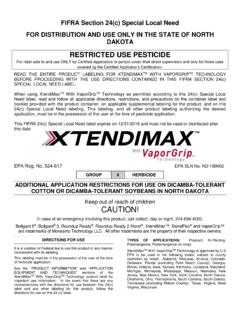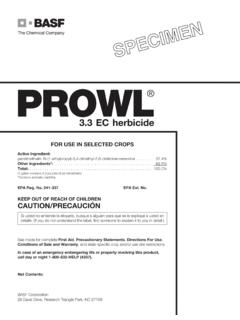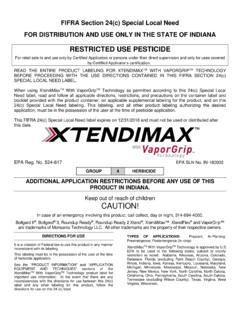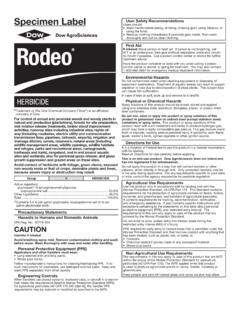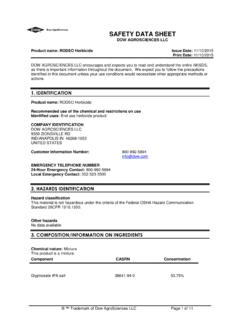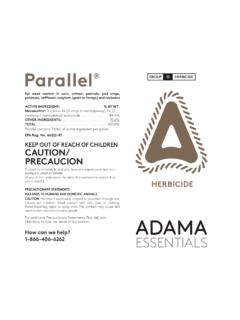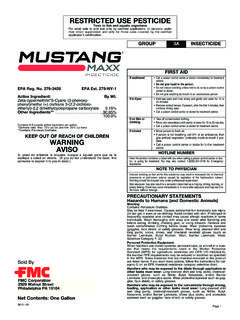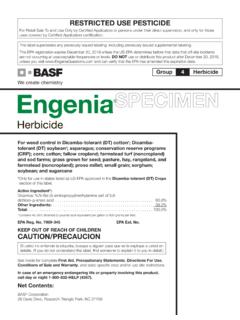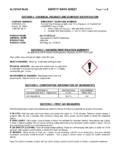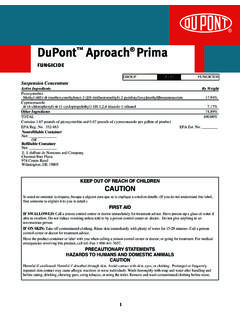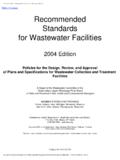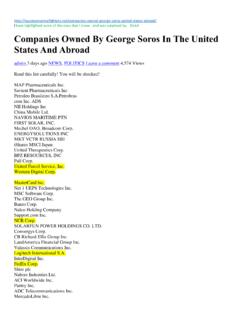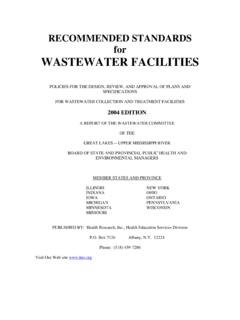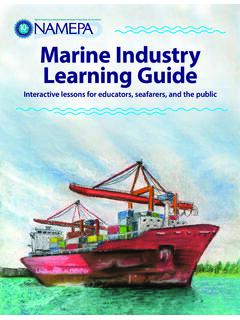Transcription of GROUP 1 HERBICIDE Section Three Herbicide
1 GROUP 1 HERBICIDE .. Section Three HERBICIDE Active Ingredient: Clethodim, (E)-2[1-[[(3-chloro-2-propenyl)oxy]limin o]propyl]-5-[2-(ethylthio)propyl]-3-hydr oxy-2- cyclohexen-1-one .. Other Ingredients*: Total: .. * Contains Petroleum Distillates Contains: lb Clethodim per gallon KEEP OUT OF REACH OF CHILDREN. CAUTION / PRECAUCION. Si usted no entiende la etiqueta, busque a alguien para que se la explique a usted en detalle. (If you do not understand the label, find someone to explain it to you in detail.). FIRST AID. If swallowed: Immediately call a poison control center or doctor. Do not induce vomiting unless told to do so by the poison control center or doctor. Do not give any liquid to the person. Do not give anything by mouth to an unconscious person. If in eyes: Hold eye open and rinse slowly and gently with water for 15-20 minutes. Remove contact lenses, if present, after the first 5 minutes, then continue rinsing eye.
2 Call a poison control center or doctor for treatment advice. If on skin or Take off contaminated clothing. clothing: Rinse skin immediately with plenty of water for 15-20 minutes. Call a poison control center or doctor for further treatment advice. If inhaled: Move person to fresh air. If person is not breathing, call 911 or an ambulance, then give artificial respiration, preferably mouth-to-mouth, if possible. Call a poison control center or doctor for treatment advice NOTE TO PHYSICIAN: Contains petroleum distillates. Ingestion of this product or subsequent vomiting can result in aspiration of light hydrocarbon liquid, which can cause aspiration pneumonitis. HOT LINE NUMBER. Have the product container or label with you when calling a poison control center or doctor, or going for treatment. FOR 24- HOUR MEDICAL EMERGENCY ASSISTANCE CALL: 1-877-424-7452. FOR 24-HOUR CHEMICAL EMERGENCY: Spill, leak, fire, exposure, or accident call CHEMTREC at 1-800-424-9300.
3 FOR PRODUCT INFORMATION CALL: 1-866-761-9397. EPA REG. NO.: 66330-414-1381 EPA EST. NO.: 070989-MO-001. NET CONTENTS: Distributed by: AD041113. Winfield Solutions, LLC. Box 64589 1/0604/5. St. Paul MN 55164-0589. PRECAUTIONARY STATEMENTS. HAZARDS TO HUMANS & DOMESTIC ANIMALS. CAUTION: Harmful if swallowed. Causes moderate eye irritation. Wash thoroughly with soap and water after handling and before eating, drinking, chewing gum, using tobacco or using the toilet. Avoid contact with eyes or clothing. Wear protective eyewear, Long-sleeved shirt and long pants, Socks, shoes and chemical resistant gloves (such as Barrier Laminate, Butyl Rubber, Nitrile Rubber, Viton, Selection Category F, G). PERSONAL PROTECTIVE EQUIPMENT (PPE). Applicators and other handlers must wear: Long-sleeved shirt and long pants Chemical-resistant gloves, Category G (such as Barrier Laminate or Viton > 14 mils).
4 O For more options, follow the instructions for Category G on an EPA chemical-resistance category selection chart. Shoes plus socks Protective eyewear Discard clothing and other absorbent materials that have been drenched or heavily contaminated with this product's concentrate. Do not reuse them. Follow manufacturer's instructions for cleaning/maintaining PPE. If no such instructions for washables exist, use detergent and hot water. Keep and wash PPE separately from other laundry. engineering CONTROLS STATEMENTS. When handlers use closed systems, enclosed cabs, or aircraft in a manner that meets the requirements listed in the Worker Protection Standard (WPS) for agricultural pesticides [40 CFR. (d) (4-6)], the handler PPE requirements may be reduced or modified as specified in the WPS. USER SAFETY RECOMMENDATIONS. Users should: Wash hands before eating, drinking, chewing gum, using tobacco or using the toilet.
5 Remove clothing/PPE immediately if pesticide gets inside. Then wash thoroughly and put on clean clothing. Remove PPE immediately after handling this product. Wash the outside of gloves before removing. As soon as possible, wash thoroughly and change into clean clothing. ENVIRONMENTAL HAZARDS. Do not apply directly to water, to areas where surface water is present or to intertidal areas below the mean high water mark. Do not apply where runoff is likely to occur. Do not apply where weather conditions favor drift from areas treated. Do not contaminate water when disposing of equipment washwater or rinsate. The use of this product may pose a hazard to the federally designated endangered species of Solano Grass and Wild Rice. Use of this product is prohibited in the following areas where the species are known to exist: Solano Grass: Solano County, California: the vernal lakes area bounded by the Union Pacific Railroad and Hastings Road to the north, Highway 113 to the east, Highway 12 to the south, and Travis Air Force Base to the west.
6 Wild Rice: Hays County, Texas Important. Read these entire DIRECTIONS FOR USE and WARRANTY AND DISCLAIMER STATEMENT before using Section Three HERBICIDE . PHYSICAL OR CHEMICAL HAZARDS. Combustible: Do not use or store near heat or open flame. DIRECTIONS FOR USE. It is a violation of Federal law to use this product in a manner inconsistent with its labeling. Do not apply this product in a way that will contact workers or other persons, either directly or through drift. Only protected handlers may be in the area during application. For any requirements specific to your State or Tribe, consult the agency responsible for pesticide regulation. AGRICULTURAL USE REQUIREMENTS. Use this produce only in accordance with its labeling and with the Worker Protection Standard, 40 CFR. Part 170. This Standard contains requirements for the protection of agricultural workers on farms, forests, nurseries, and greenhouses, and handlers of agricultural pesticides.
7 It contains requirements for training, decontamination, notification, and emergency assistance. It also contains specific instructions and exceptions pertaining to the statements on this label about Personal Protective Equipment (PPE) and restricted-entry interval. The requirements in this box only apply to uses of this product that are covered by the Worker Protection Standard. Do not enter or allow worker entry into treated areas during the restricted entry interval (REI) of 24 hours. PPE required for early entry to treated areas that is permitted under the Worker Protection Standard and that involves contact with anything that has been treated, such as plants, soil, or water, is: Coveralls Chemical-resistant gloves, Category G (such as Barrier Laminate or Viton > 14 mils). Shoes plus socks Protective eyewear. NON-AGRICULTURAL USE REQUIREMENTS. The requirements in this box apply to uses of this product that are NOT within the scope of the Worker Protection Standard for agricultural pesticides (40 CFR Part 170).
8 The WPS applies when this product is used to produce agricultural plants on farms, forest, nurseries, or greenhouses. Keep all unprotected persons out of operating areas, or vicinity where there may be drift. Do not enter or allow other persons to enter treated areas without protective clothing until sprays have dried. PRODUCT INFORMATION. Section Three HERBICIDE is a selective postemergence HERBICIDE for control of annual and perennial grasses. Section Three HERBICIDE does not control sedges or broadleaf weeds. Section Three HERBICIDE is a systemic HERBICIDE which is translocated from the treated foliage to the growing points of the leaves, shoots and roots. Uptake into the plant is primarily through its leaves. Thorough coverage of the foliage is important for consistent grass control. The treated grass weeds show a reduction in vigor and growth. Early chlorosis/necrosis of younger plant tissue is followed by a progressive collapse of the remaining foliage.
9 Depending on grass species treated and environmental conditions, symptoms will generally be observed in 7 to 14 days after application. Avoid contact of this product with desirable grass crops, such as corn, rice, sorghum, small grains, or turf as these and other grass crops will be injured or killed. RESISTANCE MANAGEMENT. For resistance management, Section Three HERBICIDE is a Weed Science Society of America GROUP 1 HERBICIDE listed under the HERBICIDE Resistant Action Committee (HRAC). Any weed population may contain or develop plants naturally resistant to Section Three HERBICIDE and other GROUP 1 herbicides . The resistant biotypes may dominate the weed population if these herbicides are used repeatedly in the same field. Where possible, rotate the use of Section Three . HERBICIDE with herbicides that have a different mode of action. Other resistance mechanisms that are not linked to site of action, but specific for individual chemicals, such as enhanced metabolism, may also exist.
10 If poor performance occurs and cannot be attributed to adverse weather or application conditions, a resistant biotype may be present. The use of Section Three HERBICIDE should conform to resistance management strategies established for the use area. Consult your agricultural advisor for resistance management strategies and recommended pest management practices for your area. Appropriate resistance-management strategies should be followed. CROPS AND USES. Section Three HERBICIDE is not recommended for use on vegetable crops being grown for seed production unless specific instructions are included in this labeling. This product is for use on the following crops and uses: Alfalfa, Asparagus, Canola*, Clover**, Corn (Field)**, Cotton, Flax*, Garlic, Hops, Mint, Mustard Seed*, Peach, Peanuts, Safflower, Sesame, Soybeans, Strawberry, Sunflower, and Root vegetables Crop GROUP Subgroup 1B [Beets (Garden), Burdock (edible), Carrot, Celeriac, Chervil (Turnip-rooted), Chicory, Ginseng, Horseradish, Parsley (Turnip-rooted), Parsnip, Radish, Radish (Oriental), Rutabaga, Salsify (Black and Spanish), Skirret, Turnip], Root vegetables Crop GROUP Subgroup 1C [Arracacha, Arrowroot, Artichoke* (Globe, Chinese and Jerusalem), Canna (Edible), Cassava (Bitter and Sweet), Chayote (Root), Chufa, Dasheen, Ginger, Leren, Potato, Sweet Potato, Tanier, Tumeric, Turnip, Yam (Bean and True)], Leaves of Root and Tuber Vegetables Crop GROUP 2 [Beet (Garden and Sugar), Burdock (edible), Carrot, Cassava (Bitter and Sweet), Celeriac, Chervil (Turnip-rooted)]
